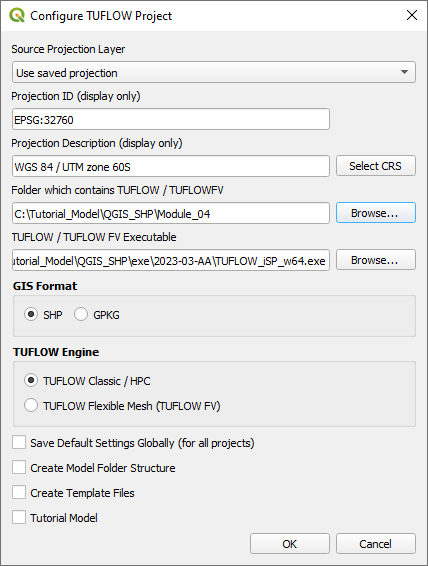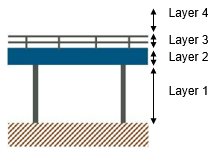Tutorial M04 GIS Inputs QGIS: Difference between revisions
Jump to navigation
Jump to search
Content deleted Content added
No edit summary |
No edit summary |
||
| Line 37: | Line 37: | ||
:*Layer 3: The bridge rails. |
:*Layer 3: The bridge rails. |
||
:*Layer 4: Flow above the rails (assumed to be unimpeded). |
:*Layer 4: Flow above the rails (assumed to be unimpeded). |
||
Refer to the <u>[https://docs.tuflow.com/classic-hpc/manual/latest/ TUFLOW Manual]</u> for more information on the attributes.<br> |
|||
<br> |
<br> |
||
{{Video|name=Animation_M04_GIS_01b.mp4|width=1232}}<br> |
{{Video|name=Animation_M04_GIS_01b.mp4|width=1232}}<br> |
||
Latest revision as of 09:53, 23 September 2024
Introduction
QGIS is used to create, import and view input data.
TUFLOW Project Re-Configuration
Re-configure the TUFLOW project to use and save empty files to the correct folder:
- Go to Plugins > TUFLOW > Editing > Configure / Create TUFLOW Project.
- Change the folder which contains TUFLOW to the Module_04 folder. This is the only change required, the model folder structure and template empty files are supplied from previous model.
Note: The 'results' and 'check' folder get automatically created when the TUFLOW model is run.
- Click 'OK' and save the QGIS workspace by selecting Project > Save As.
- Set the QGIS workspace projection to EPSG:32760, see Set the Projection.
Method
Navigate to the Module_04\Tutorial_Data folder. Copy and save all the below layers into the Module_04\TUFLOW\model\gis folder:
- 2d_lfcsh_M04_bridge_001_L
- 2d_po_M04_001_L
- 2d_po_M04_001_P
- 2d_zsh_M02_cut_002_R
Investigate the supplied files:
- Open the files, either:
- Drag and drop the .shp files into the QGIS workspace, or
- Select Layer > Add layer > Add Vector Layer and navigate to the Module_04\TUFLOW\model\gis folder.
- The 2d_zsh file cuts through the road embankment, see Module 2 for more information.
- The 2d_lfcsh represents the bridge in 2D, it has layers of varying blockage and form loss for piers, bridge deck and railings. The layers of the bridge structure are defined as:
- Layer 1: Beneath the bridge deck.
- Layer 2: The bridge deck.
- Layer 3: The bridge rails.
- Layer 4: Flow above the rails (assumed to be unimpeded).
Refer to the TUFLOW Manual for more information on the attributes.
- The 2d_po files include a structure group output for the 2D bridge. The 'Label' attribute links the 2d_po line to the 2d_po points by the same attribute ‘Bridge’.
- The 2d_po line is snapped to the 2d_lfcsh from left to right looking downstream and has the following attributes:
- Type = QS (structure flow)
- Label = Bridge
- The 2d_po points are digitised upstream and downstream of the 2d_lfcsh and have the following attributes:
- Type = HU (water level upstream) and HD (water level downstream)
- Label = Bridge
Conclusion
- The 2d_lfcsh layer was supplied for use as a 2D bridge.
- The 2d_po structure group layers were added to output additional hydraulic information of the 2D bridge.
| Up |
|---|

